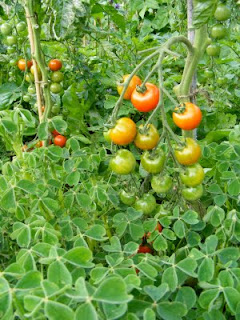After some consideration I decided to bi-crop with tomatoes as the primary crop.
So ... Action-points for this season:
- Use a more formal multi-crop structure.
- Allow more space for the ultimate size of the foliage.
- Hold out for as late a harvest date as possible.
- Keep better records of dates, spacing etc.
Early March. As previously, I chitted tubers indoors.
Although the tubers saved from the previous season are technically genetic clones, I noticed one tuber sprouted much earlier than the others. Another was a much darker colour. Some mutation does occur, so I have labelled them and will see if the characteristics are passed on.
25th March, planted in pots in an unheated greenhouse.
25th March, planted in pots in an unheated greenhouse.
28th April. Planting out. The plants will be placed in a single row down the centre of a 4ft wide bed (hopefuly giving enough space for the Autumn spread) alternating with the primary crop of cordon grown tomatoes. Spacing is about 20 inches between each tomato, with an Oca between each. Space on either side will be used for spring-sown, fast-maturing crops, which will be harvested before the space is taken by the Oca.
The bed has had an early (sown in February under plastic) green manure crop of mustard. Without disturbing this, 7ft canes are placed ready for the tomatoes, and ...
...the Oca are transplanted in small clearings giving them some protection from any cold wind.
By 9th June, the mustard is long gone and the interplanted tomatoes are knee-high. Direct-sown salad crops are up (here, landcress and spring onions, not visible are module-sown beetroot and lettuce) The tomatoes have received a layer of mulch to encourage stem-rooting and the Oca is still well-behaved.
By 1st August the fast-growing side crops are mostly harvested, just in time for the Oca to spread dramatically.17th August. Tomato cropping is in full flow. The single row of oca is providing complete ground cover across the 4ft bed. The tomatoes have been stripped of leaves over their lower third to aid ripening and ventilation. This also lets in more light to the oca.
1st of November. Blight and cold weather have just about finished off the tomatoes. The Oca is thriving in the cool temperatures and increased moisture levels.
.... and show the first signs of tuber formation. Stems in contact with the ground produce thick fleshy roots which form a tuber at the end.

(6th December) A light frost has damaged the outermost foliage. This seems to have stimulated tuber formation. There are huge numbers of tubers forming where the stems are touching the soil.

(20th December) Two weeks later there have been several proper frosty nights. The crucial period for tuber growth is now!

The plant guild offers up an unexpected bonus crop; the Spring-sown land cress has survived the hot Summer under the Oca, and is now making a come-back through the collapsed stems.

31st December. The foliage is well and truly dead. Surely time to harvest!

For harvest results go here



















